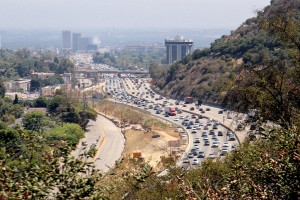After I first moved to Los Angeles in 1999, I got a job at a record company in Santa Monica. Being new and shocked by the traffic, I remember asking one of my co-workers about his commute. He lived in the San Fernando Valley, which meant a dreaded daily ride on Interstate 405 over the Santa Monica Mountains, through the bottleneck of the Sepulveda Pass. I shuddered in horror and asked him how he managed.
“I watch Lakers games,” he told me.
That didn’t make sense to me (especially being in the era before the smart phone): how could he drive and watch the games at the same time?
“I bring a small TV with an antenna and put it on the passenger seat,” he explained. “Traffic moves so slowly I can catch most of the game.”
I couldn’t help thinking of this long-lost colleague on Friday. That day, Los Angeles County’s transportation agency released a bold $120 billion long-term transportation plan with projects that would be funded if two-thirds of the voters approve a November half-cent sales tax increase.
The centerpiece of the plan? A transit tunnel and toll road for that 405 corridor.
To meet that two-thirds hurdle, L.A. Metro will need this kind of big, splashy project to capture the public imagination. It will also need to spread the goodies around the county to keep everyone happy (the benign sounding expression to describe this dynamic is “geographic equity”). And the plan has plenty of the transportation Santa Claus in action, with gold-plated rail extensions to the low-density San Gabriel Valley as the most prominent example.
Otherwise, there’s certainly a lot to like:
- The badly needed Wilshire subway to Westwood would be accelerated by a decade.
- Heavily traveled Vermont Avenue in South Los Angeles would get a bus rapid transit line (back in the 1980s planners wanted the Blue Line light rail to be heavy rail underneath this road).
- The crowded and too-slow Orange Line busway in the San Fernando Valley would get grade separations to speed it up.
- The aforementioned toll road on and transit tunnel under 405 could potentially bring in private funding for transit improvements to this crowded corridor. It’s a model the region needs to explore given the lack of public funds for big infrastructure projects.
What’s not to like? Well, in addition to the gold-plated project discussed above, there are a lot of highways involved, as seems to be required with transportation sales tax measures (an all-transit tax doesn’t get you the two-thirds approval you need).
One highway project stands out as particularly destructive: Supervisor Antonovich’s pet “High Desert Corridor” project, which would link Palmdale to Victorville along the base of the San Gabriel Mountains. Eventually the route would provide a path for California’s high speed rail project to connect to the Las Vegas high speed line, which currently is planned to end in Victorville.
But building this highway project will only encourage sprawl development in a beautiful part of the county, far from jobs and requiring long commutes of anyone who lives there. The high speed rail line won’t help, as it will be too expensive for daily commuting.
In the end, transportation leaders will need to run a flawless campaign to get the voters to approve this plan. The measure is apparently polling at 70%, which is a good start, but an anti-tax opposition campaign, coupled with any agency mishaps (like a construction accident or scandal) could sink it quickly. And debates over transit-oriented density could also sap support.
But Angelenos are clearly fed up with the status quo on transportation and seem poised to tax themselves again at record levels.
Because passing the time while stuck in traffic watching a Lakers game is simply not a sustainable option.
2 thoughts on “L.A.’s Bold Transportation Vision”
-
Pingback: Union Politics And The BART Bond | Ethan Elkind
-
Pingback: Doubling Down On L.A. Sprawl In The High Desert | Ethan Elkind
Leave a Reply
You must be logged in to post a comment.



